It increasingly feels like we are nearing an inflection point when it comes to energy consumption, production, and the combatting of climate change.
On the one hand, new temperature records are being set around the world, environmental movements are gaining traction, and governments are pursuing steadily more aggressive emission reduction policies.
On the other hand, renewed geopolitical instability, underinvestment in fossil fuel production, and a global rebound in energy demand after the pandemic have sent prices soaring and put energy security back into the limelight.
Balancing these two factors - energy security and emissions reduction - promises to be the central challenge for the global energy industry going forward as the world attempts to map out an energy transition.
In the meantime, the debate around different forms of geoengineering is intensifying, with some seeing it as a dangerous distraction while others insist it is the only viable path forward to counter climate change.
The truth, as usual, lies somewhere in between. Each method of geoengineering has pros and cons, and any attempt at finding the optimal path to emissions reduction will be undermined by efforts either to exaggerate the threat geoengineering poses or overstate its potential.
What is geoengineering?
Geoengineering refers to deliberate, large-scale interventions in Earth's natural systems to counteract climate change or mitigate its effects. These interventions are broadly divided into two groups, carbon dioxide removal (CDR) and solar radiation management (SRM).
The first of these, CDR, is focused on removing carbon dioxide from the atmosphere in order to reduce the amount of solar heat that is trapped in Earth’s atmosphere via the ‘greenhouse effect’. Popular methods of carbon dioxide removal include carbon capture and storage, ocean geoengineering, afforestation, and enhanced rock weathering.
The second type of intervention, SRM, is designed to reflect a portion of the sun's energy away from Earth, thereby reducing the amount of solar heat that can be trapped in the atmosphere. Solar radiation management techniques include injecting aerosols into the stratosphere, ‘brightening’ clouds, and even placing reflective surfaces in space to reduce the amount of sunlight reaching Earth.
Perhaps unsurprisingly, it is this second method that is generally deemed the most controversial form of geoengineering, with the first method attracting far more attention and investment.
Carbon Dioxide Removal
In recent years, as pressure to decarbonize has climbed, carbon dioxide removal has well and truly gone mainstream. The six most prominent methods are carbon capture utilization and storage, direct air capture, bioengineering with carbon capture and storage, ocean geoengineering, afforestation, and enhanced rock weathering.
While each of these methods faces its own unique challenges, the unifying problems for all of them are scalability and cost. In 2023, global CO2 emissions are set to climb to 40.9 gigatons (Gt CO2). To put that in perspective, a study released in January 2023 suggested that just 2 Gt CO2 was being removed from the atmosphere each year and only a minuscule fraction of that (0.002 Gt CO2) came from novel technologies and methods. The vast majority of current carbon removal is done by the world’s forests and oceans.
With that in mind, here is a brief overview of the main approaches and their potential.
Carbon Capture, Utilization, and Storage (CCUS)
Carbon Capture, Utilization, and Storage (CCUS) is a method of carbon removal that has been around for decades, but in recent years its development has accelerated dramatically. In CCUS, CO2 is captured directly at a power station, industrial plant, or other high-emission site and either used in another process or transported to a storage site.
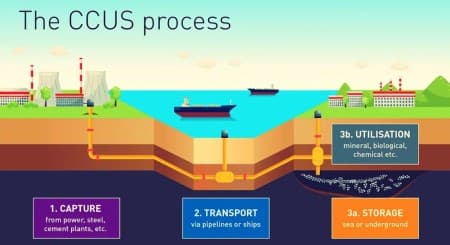
Source: Carbon Credits
The captured carbon can then be used in the production of plastics, concrete, or efuels. Interestingly, the same characteristic that makes plastic a nightmare when it comes to pollution - namely that it is so difficult to break down - means that it is a very effective way to store carbon. Technically, making plastic from carbon capture could be a carbon-negative process.
Within the oil and gas industry, enhanced oil recovery (EOR) is the most common form of CCUS. By injecting captured carbon dioxide into existing oil wells, companies can extract an additional 30 to 60 percent of the reservoir's original oil in place while effectively storing the carbon underground. Critics of this technique point out that it results in an increase in oil production which could ultimately mean more emissions rather than less. The upsides, however, can include a reduction in flaring, increased demand for captured carbon dioxide, and ultimately fewer oil wells being drilled.
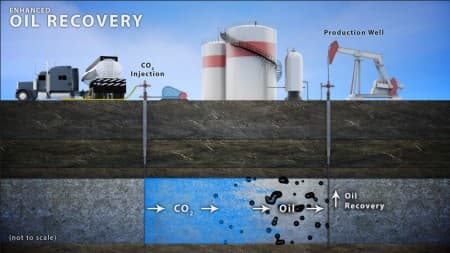
Source: National Energy Technology Laboratory
According to McKinsey analysis, the global capacity of CCUS needs to climb to 4.2 Gt CO2 by 2050 for countries to achieve their net-zero commitments. Currently, there are 40 commercial capture facilities in operation globally, with a total annual capture capacity of around 45?Mt CO2.
Direct Air Capture
Direct Air Capture (DAC) has the potential to not only reduce carbon emissions but to reduce the total amount of carbon in the atmosphere. The process involves using renewable energy to extract carbon dioxide directly from the air and then store it deep underground.
With carbon dioxide making up just 0.04% of the Earth’s atmosphere, the major challenge for DAC is the volume of air that must pass through the system to remove any significant amount of CO2. This makes direct air capture very energy-intensive and very expensive.
A major advantage for DAC plants is that they are not limited by location, meaning they can be built wherever there is an excess of clean or low-carbon energy. With that said, further testing is needed to confirm the efficacy of this technology in extremely dry or humid climates.
The largest DAC plant currently in operation is Climeworks’ Orca plant, which uses geothermal energy to remove 4000 tonnes of CO2 per year.

Source: Climeworks
The 27 DAC plants that have been commissioned to date worldwide capture around 0.01?MtCO2 per year. In the IEA’s Net Zero Emissions by 2050 Scenario, DAC capacity would need to climb to 1.2 GtCO2 per year. With 130 DAC facilities now at various stages of development, and with projects having a lead time of two to six years, that target is technically achievable but would require heavy investment and a significant reduction in the cost of the technology.
Bioenergy with Carbon Capture and Storage (BECCS)
Bioenergy with carbon capture and storage (BECCS) is another CDR method that has the potential to have net negative emissions, it is also the only method that also produces energy. This process uses biomass to create energy and then stores the CO2 emitted in the process of burning the biomass.
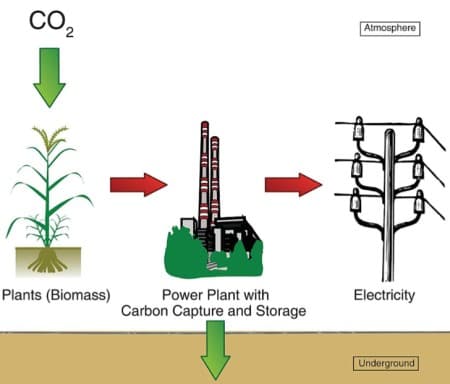
By far the most common form of bioenergy being used today is bioethanol, which acts as a fuel and can be blended with gasoline. Of the 2 Mt CO2 of biogenic sources being captured annually, bioethanol accounts for 90% of it. Less than half of that captured CO2 is currently being stored in dedicated storage, with the rest being used in processes like enhanced oil recovery or yield boosting in greenhouses.
As well as fuel, bioenergy can be used for industry, power, and heating. Recently announced BECCS projects include heat and power plants in Denmark, cement plants using biomass feedstock in Norway and Sweden, pulp and paper mills looking to use bioenergy in Canada, and even hydrogen facilities.
By 2030, carbon removal via BECCS could climb to just under 50 Mt CO2 per year based on current plans, well below the IEA’s target of 190 Mt CO2. In that target, biofuels would be removing 130 Mt CO2, the power sector would be removing 40 Mt CO2, and industry would be removing 20 Mt CO2.
The two main concerns for BECCS include the amount of land used to grow the biomass and the potential of leaks of carbon dioxide throughout the system. This approach also faces significant cost and scalability challenges.
Ocean Geoengineering
Of all the carbon stored on Earth, the vast majority of it can be found in the ocean. While the air holds 875 billion tons of carbon and land holds 3.5 trillion tons of carbon, the ocean holds a remarkable 40 trillion tons of carbon.
Ocean geoengineering is the attempt to boost the ocean’s capacity to hold carbon through one of two methods. The first method involves cultivating ocean life to increase the amount of carbon that ultimately ends up in ocean forests or on the seafloor. The second method involves altering the composition of the ocean itself so that the seawater can hold more carbon.

Source: frontiersin.org
The first of these methods focuses on altering ocean ecosystems to ensure more carbon ends up on the seafloor. One example of this method is ocean fertilization, which involves adding nutrients to the surface of the ocean in an attempt to boost phytoplankton, the phytoplankton then absorb carbon dioxide from the atmosphere, are eaten by fish, and the carbon ends up on the sea floor. Perhaps the most well-known project is the one being led by David King, former chief scientific adviser to the UK government, which aims to stimulate phytoplankton with artificial whale poo.
The second method, which is an increasingly popular field of study, involves altering the chemical composition of seawater to boost its carbon uptake. When carbon dioxide in the atmosphere dissolves in seawater, it is converted into carbonic acid. Carbonic acid then reacts with carbonate in the ocean to form bicarbonate which traps the carbon in a stable form. As carbon dioxide levels in the atmosphere have risen, the world's oceans have absorbed more and more carbon, decreasing the concentration of carbonate and increasing the acidity of the ocean. By adding alkalinity to the ocean, scientists hope to reverse this trend and, in doing so, increase the ability of seawater to absorb more carbon dioxide.
The main issue facing ocean geoengineering is the same one that the SRM techniques looked at below have to deal with. The size of the intervention required means that we will have very little ability to accurately measure it or fully understand its consequences. It would also need international governance due to the interconnected nature of the world’s oceans. Proponents of this approach claim that we are already intervening in the ocean by increasing its acidity and have a responsibility to reverse or limit those changes.
Afforestation
Planting trees is perhaps the most well-known form of carbon sequestration and is not normally associated with geoengineering. Afforestation is the one form of tree planting that can be considered geoengineering as it involves establishing a forest in an otherwise treeless environment.
Afforestation has been taking place around the world for decades and for a variety of reasons. In 1935 under FDR’s New Deal, the Prairie States Forestry Project saw the planting of millions of trees from Texas up to Canada in order to counter soil erosion and unemployment. In China, the Three-North Shelter Forest Program, which was started in 1972, was designed to halt desertification and hold back the expansion of the Gobi desert. Similarly, in 2007, Africa’s Great Green Wall was launched as an attempt to hold back the Sahara desert by planting trees from Djibouti to Senegal.
Now, as efforts to boost carbon dioxide removal grow, afforestation is gaining attention as a potential tool for countering climate change. A 2019 study published in the journal Science suggests there is potential for a further 0.9 billion hectares of forest on earth, representing a 25% increase in forested area and an additional 200 Gt of sequestered carbon.
As with all CDR methods, afforestation has its drawbacks and uncertainties. Firstly, if carried out on the wrong land or with the wrong trees, it can damage local ecosystems and drain areas of water. There are also questions of cost and land use, especially when you consider it can take a century for forests to reach maturity. Finally, it remains unclear how the climate will react to massive global afforestation efforts, especially considering the albedo changes which could have a warming effect on the planet (something we will touch on again below).
Enhanced Rock Weathering
Enhanced rock weathering is a carbon dioxide removal method that attempts to accelerate a natural geological process that removes carbon from the atmosphere. As rocks are weathered, elements released by the rocks react with the carbonic acid in rainwater, extracting the carbon and forming a carbonate such as limestone. In this way, carbon is taken out of the air and stored in rocks.
Accelerating this process requires higher temperatures, more rainwater, a greater surface area, or the addition of a catalyst. The solution that most researchers are looking into involves grinding up rocks (most commonly Olivine as it weathers quickly) into dust and spreading it across land or even the surface of the sea. Some projects look at spreading certain rocks across farmland to both capture carbon and improve crop yields. A 2020 study estimated that enhanced rock weathering could capture up to 2 Gt CO2 per year.
Until recently, the largest problems for this method were questions of cost and energy use. Mining the rock necessary for large-scale projects is both expensive and energy-intensive. This challenge could be counteracted by using waste from mines and using the rock itself as a fertilizer on farmland to increase yields. Even then, questions of the secondary effects of such a complex process, including the potential to harm natural ecosystems and even human health, are yet to be addressed.
A recent study published in the journal Nature has raised even more significant questions about the effectiveness of enhanced rock weathering. The study shows that rocks can be a carbon source as well as a carbon sink. As rocks are weathered, the organic carbon within rocks can be oxidized, with the study finding that the CO2 release from rocks due to weathering could rival or even exceed CO2 drawdown. There is still plenty of research to be done on this topic.
The Carbon Dioxide Removal Debate
While none of these technologies are a panacea for the problems of rising CO2 levels in the atmosphere, each of them could play a part in broader efforts to reduce net global emissions. As always, projects would have to be scrutinized, regulated, and costed on an individual basis, dividing vanity projects from those that have a realistic chance of making a difference. Proof that each project has little to no impact on its local ecosystem should be a necessary step in any permitting process.
The one common critique across all CDR approaches is that they may end up being counter-productive if they are seen as an alternative to reducing emissions. Some even argue that the money pouring into CDR might be better served building out clean energy capacity and battery storage, particularly due to the incredibly high cost of carbon dioxide removal. That argument, among other things, doesn’t address how the emissions from hard-to-decarbonize industries such as steel, cement, and petrochemicals would be dealt with.
Most net-zero scenarios see CDR as playing some role in global efforts to reduce emissions - the question is around how big that role should be and which methods should be embraced. The graph below gives some sense of just how extensive and expensive the task would be.
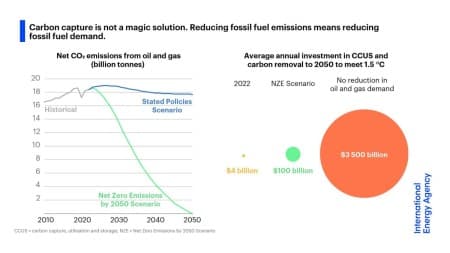
Regardless of the relative strengths and weaknesses of these methods, one thing that is undeniable about carbon dioxide removal is that its impact will take decades to be felt. Even if global emissions were to stop rising today (which they aren’t on track to do), the gap between annual emissions and the amount of carbon dioxide being sequestered each year would remain enormous.
By comparison, solar radiation management could have a dramatic and rapid effect on global temperatures, making it both more exciting and more controversial as a form of geoengineering.
Solar Radiation Management
Solar radiation management was recently described by the UN Environment Programme (UNEP) as “the only known approach that could be used to cool the Earth within a few years”. It has the potential to be both far cheaper and far faster acting than any CDR method.
At the same time, critics warn of the unknown side effects of ‘playing god’ in such a way, and note that it would be impossible to predict the knock-on effect of such a dramatic change in such a large system. These concerns led UNEP to conclude that the deployment of SRM technology is “not currently warranted and would be unwise”. Despite that conclusion, the report suggests the approach needs to be better understood and that further scientific assessments would be valuable.
Here is a brief overview of the most popular SRM techniques.
Stratospheric aerosol injection
Stratospheric aerosol injections involve spraying aerosols high up into the stratosphere to mimic the cooling effect of large volcanic eruptions. These aerosols, such as sulfur dioxide, combine with water to form sulfuric acid aerosols, which reflect incoming sunlight. Proposed methods include using planes or high-altitude balloons to release aerosols, a process that would have to be repeated every year or two to maintain the effect.
While the science is fairly clear that this approach would lead to a reduction in global temperatures, there are multiple concerns about the real-world implications of implementing it. The first problem is that there is no way to control where the particles would go after being released, with the possibility that they would all accumulate in one area or hemisphere. If that were to happen, rain patterns could be altered, leading to droughts or floods.
A second problem with this approach is that there is no way to test its effect in a small experiment. The only way to test this method would be to run it at a global scale, and even then there would be no way in the short term to establish the difference between its effect and natural fluctuations in the weather.
If the world did agree to a global aerosol injection experiment, if the earth then cooled in the desired way, and if there were no negative side-effects at all, one major question would then immediately present itself. Who gets to control the Earth’s temperature? Inject slightly more or slightly less and harvests in one region might soar or new trade routes in other regions could open up.
Finally, there is the “termination shock” problem. As SRM techniques do not lower the amount of carbon dioxide in the atmosphere, if aerosol injections were to stop then the Earth’s temperature would rapidly rebound.
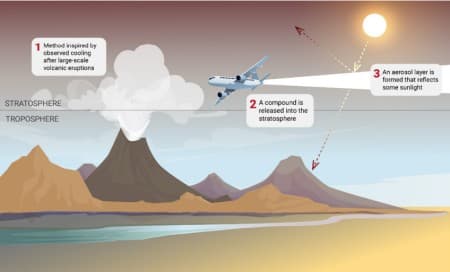
Source: UNEP Report
Of all the SRM methods, aerosol injection is the one with the potential to most dramatically and rapidly lower global temperatures. For that reason, scientists and entrepreneurs are already pushing ahead with new research and projects. Some projects, such as the SCoPEx experiment, which is designed to better understand how aerosols alter stratospheric chemistry, are working to further develop our understanding of this method. Others, like the efforts of controversial startup Make Sunsets, are already launching sulfur balloons into the stratosphere in the hope they will cool the earth. It’s perhaps not surprising that calls for regulation and international cooperation in this area are growing louder.
Marine cloud brightening
This technique aims to brighten marine clouds, the lowest clouds in the sky, by using ships to spray saltwater (or potentially other particles) into them. The salt particles would act as cloud condensation nuclei, increasing the number of droplets in the cloud which, in turn, would increase the albedo or reflectivity of the cloud. With more reflective clouds, more solar radiation is then redirected back into space.
Interestingly, what can be seen as a cloud-brightening experiment has been taking place in shipping channels around the world for years. The aerosol particles released from ship exhausts into stratocumulus clouds have resulted in an observable brightening of clouds that can be seen in ‘ship tracks’. The recent implementation by the IMO of regulations designed to lower air pollution from shipping has reduced this cloud-brightening effect and has potentially resulted in additional global warming.
One of the key concerns of marine cloud brightening is that it could alter rain patterns, although its effect is likely to be smaller than that of stratospheric aerosol injection. New research suggests cloud brightening might even be case-specific, with the effect altered by the cloud itself and by the size of the particles being sprayed.
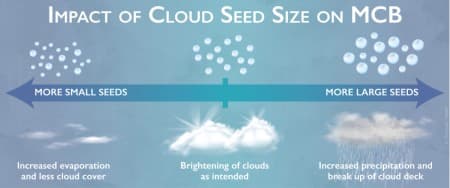
Source: NOAA Research
Currently, cloud brightening is being used in Australia in an attempt to mitigate coral bleaching on the Great Barrier Reef, and the researchers appear optimistic from the first results. Whether this could or should be used on a global scale remains to be seen.
High-albedo crops, buildings, and oceans
It isn’t just clouds that scientists are looking to boost the albedo of, there is also research into increasing the reflectivity of crops, buildings, and the ocean. Higher albedo surfaces will reflect more light, meaning the air near those surfaces will be cooler. The Earth’s average albedo (with 1 meaning all sunlight is reflected and 0 meaning all sunlight is absorbed) is 0.3, which means it reflects about 30% of the solar radiation that reaches it.
While surfaces like snow and ice have high albedos of 0.7. or 0.8, forests will absorb a majority of the light that reaches them - with an albedo of 0.15. This was touched on above as a potential downside to afforestation. Urban areas, meanwhile, can have different albedos depending on the material used.

For farmland, increasing albedo involves either selecting more reflective crops or introducing genes that give plants a waxy sheen. In cities and towns, painting rooftops with light colors or using reflective material will decrease albedo and has been shown to influence temperatures.
When it comes to altering the albedo of the ocean, potential methods include dispersing microbubbles in the ocean, increasing ocean foams, and altering the chemistry of ship’s wakes to make them last longer.
While lowering albedo has been seen to have an effect on microclimates, its global impact on temperatures remains unclear. For cities in warm areas, projects designed to lower albedo can both reduce the threat of heat waves and lower energy consumption. When it comes to high-albedo crops, the potential side effects on crop productivity need to be carefully considered as well as any broader impact on local ecosystems. Similarly, the impact of increasing ocean albedo could alter marine ecosystems, especially as it could reduce light penetration and hinder photosynthesis in marine plants.
Cloud thinning
The penultimate SRM technique on this list, cloud thinning would take place below stratospheric injections and above marine cloud brightening. It aims to reduce the warming effect of cirrus clouds, which trap heat. By injecting solid aerosol particles, such as desert dust or pollen, into these clouds, these clouds would dissipate more quickly, allowing more solar heat to escape into space. The difference between cloud thinning, cloud brightening, and aerosol injection can be seen in the diagram below.

Source: UNEP Report
While this approach has been studied in climate model simulations and theoretical analysis, there have been no notable outdoor field experiments recorded. The feasibility of this approach is uncertain due to a lack of knowledge of how particles would react in high clouds.
As with other SRM approaches, cloud thinning has the potential to alter precipitation patterns and regional temperatures. There is also the possibility that it would result in more solar radiation reaching the earth's surface. More research is needed to be sure of the feasibility of this approach.
Space sunshades
Saving the most dramatic SRM method for last, developing a space sunshade would involve launching a giant mirror into orbit to reflect away sunlight before it enters the atmosphere. The ideal place for this mirror has already been established as the L1 Lagrange point. This is a point in space where the solar radiation pressure and gravity of the Earth and the Sun are in balance. Unfortunately, to work in this area the sunshade would need a minimum surface density well above what would be plausible.

Recently, a scientist came up with a method that would dramatically reduce the mass required for a space sunshade in the L1 Lagrange point to work. This new plan involves counterbalancing the sunshade by tethering it to an asteroid or moondust. This approach would reduce the necessary mass of the sunshade leaving Earth to just 35,000 metric tons.
While theoretically effective, the technological challenges, lead time, and the need for ongoing adjustments would make this the most complex and expensive option. Even if those problems were to be overcome, the question of governance would once again raise its head.
Is It Time To Embrace Geoengineering?
In many ways, the debate around geoengineering has parallels to that of artificial intelligence. Defusing both the hype and hysteria around this topic will be critical to any effective implementation effort. On the one hand, the idea that geoengineering can do all the heavy lifting when it comes to emissions reduction is both unproductive and unrealistic. On the other hand, ignoring or unilaterally banning these technologies and approaches would be both ineffective and unwise.
As touched on above, carbon dioxide removal has largely gone mainstream and, while its effectiveness may be questioned, there seems to be little reason why most of these methods shouldn’t continue to be pursued. Critically, they should be used in conjunction with emissions reduction rather than in lieu of any emissions reduction efforts, with each project analyzed for its net impact on emissions. Ocean geoengineering is perhaps the most controversial of this category, requiring further research, global cooperation, and stringent regulation.
When it comes to solar radiation management, the rapid and global nature of its potential impact should be reason enough to pause its immediate deployment. With that said, its unique potential to cool the Earth in a short time frame justifies further research, investment, and international cooperation.
In answer to the question, then, embrace might be too strong a word, but geoengineering certainly isn’t something we can afford to ignore. The degree to which we will need or use different methods in the future remains unclear, but without proactive investment, preparation, and regulation, we simply won’t have the option.
By Josh Owens for Oilprice.com
More Top Reads From Oilprice.com:
- The 10 Most Influential Figures In The History Of Oil
- Oil Prices Poised to Bounce Back in 2024
- Analysts Say Oil Prices Unlikely To Hit $100 In 2024



















Yet, I don't agree with the albedo effects concerning afforestation. While forests reflect less (absorb more) of the sun's energy, they are always more temperate than the land in the same area that is either bare soil, inhabited, or cropped. The humidity released is greatly beneficial to the environment, both micro and macro. Also while they sequester CO2, what is far more important is the O2 they produce. There is a far different quality to the air in a forested area than even in cropped land. Large forested areas 'attract' rain (generally because they are cooler). And that attracted rain is a natural coolant, even in humid Florida!
Note I am an arboriculturist/orchardist (tree farmer), so I have a bit of a bias toward trees.
Forming thin clouds to dim the sunlight will cause very, very serious disastrous drought by not letting the atmosphere work with heat from the sum to create precipitation. Differences in temperature are what create weather, not just the temperature.
Painting surfaces lighter colors is maybe the most effective method, and is just plain common sense. "Common" people have been doing this all along. Even something as simple as this can be a problem since lighter surfaces can also reflect enough light to make driving dangerous if too much light gets into drivers' eyes for instance.
Many things that do work to diminish any warming effects of CO2 are already done without thinking about this subject by people in everyday life. We do NOT need things done the same everywhere. The last thing we need is thinking that what is good for one area is also good for another and this is exactly what would cause the seriously disastrous effects of geoengineering.
If you are worried about CO2, use it for constructive purposes as is mentioned several times in the article.
Plants could actually use a lot more CO2 in order to meet there potential for more growth (and food production). Several times what we have now would be great for plants. At the level it is now, the actual effect of CO2 on our temperature is negligible. Not mush would have to be removed to start effecting plant life. I know it seems silly to "experts', but some of us like more CO2 for more plants to create more O2 for us.
Remember, the CO2 level is at a very low number when looking through geological history. We need more, not less.